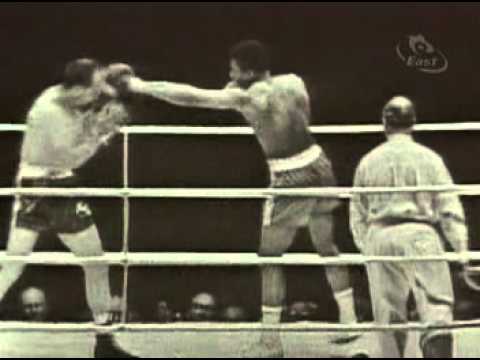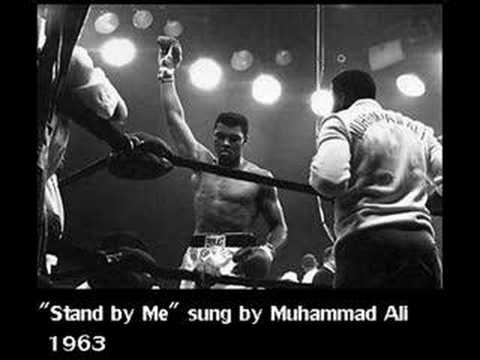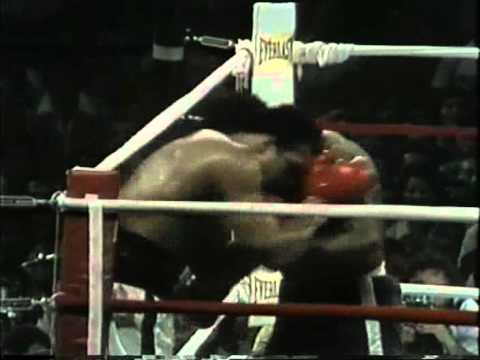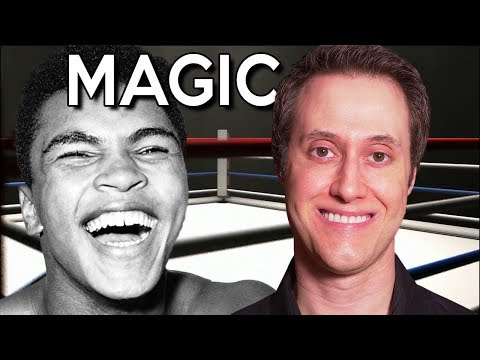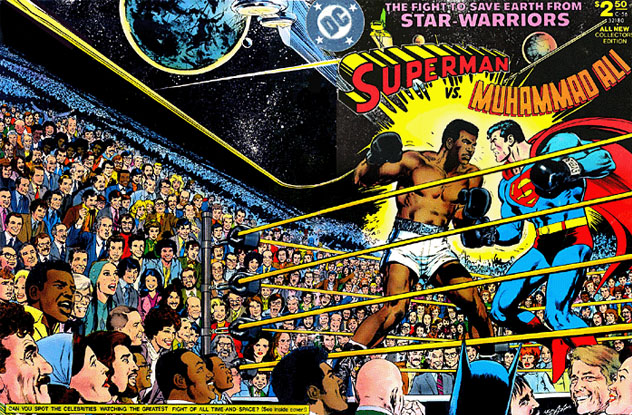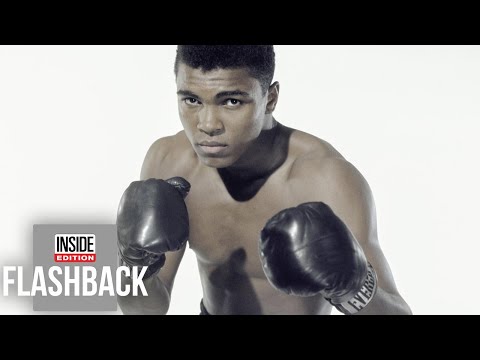10A Stolen Bicycle Inspired His Career
Before he could float like a butterfly and sting like a bee, Muhammad Ali was a 12-year-old boy looking for revenge. It was October 1954, and Ali (still known as Cassius Clay) was the proud owner of a red Schwinn bicycle. It was a Christmas gift from his dad, and he planned on riding it to a bazaar in his hometown of Louisville, Kentucky. He and a buddy spent the day checking out the stalls and munching on popcorn, but when Ali was ready to go home, he found someone had stolen his prized bike. Tears streaming down his face, Ali headed to a local gym, looking for Joe Martin, a cop who just so happened to be a boxing coach. He explained his situation to Martin and threatened to “whup” whoever stole his bike. Looking the skinny kid up and down, Martin advised, “You better learn to fight before you start fighting.” After helping Ali fill out a police report, Martin handed him a gym application. Six weeks later, Ali won his very first fight on local TV, beating a kid named Ronny O’Keefe by a split decision. Martin would go on to teach Ali the basics of boxing, and together they’d win six Kentucky Golden Glove titles, two national Amateur Athletic Union titles, and eventually a gold medal in the 1960 Rome Olympics. Of course, Ali never got his bike back, but if he ever actually met the thief, he’d probably shake his hand.
9He Was Afraid Of Flying
While Ali was getting ready for the 1960 Rome Olympics, he realized he’d have to fly there. Terrified, the 18-year-old asked if he could take a boat ride instead. When his idea was shot down, Ali decided winning a gold medal wasn’t worth risking a plane crash and decided to skip the Olympics. Fortunately, boxing coach Joe Martin talked Ali into flying, although the fighter still needed extra assurance. Before takeoff, Muhammad bought a parachute and wore it all the way to Italy. Some even say he prayed the whole flight, while others claim he kept his mind off any possible catastrophe by bragging about his upcoming bouts. Either way, he got there in one piece. Still, Ali wasn’t a fan of soaring through the sky, and when he returned to the States, he bought himself a bus for future tours, stating that when buses break down, they don’t fall 30,000 feet. Not until later in life did Ali claim to have overcome his fear. After his conversion to Islam, he said Allah wouldn’t let him die in a plane crash. However, his daughter Maryum Ali still said, “The only time I’ve seen my father scared is when we’re in the air, and the plane starts shaking. That’s when his eyes get real big, and he definitely wants to be on the ground.”
8He Didn’t Toss His Gold Medal
Americans certainly like their myths. But despite countless retellings, George Washington didn’t chop down a cherry tree, Walt Disney isn’t cryogenically frozen, and Muhammad Ali didn’t toss his Olympic medal into the Ohio River. But unlike the Washington and Disney legends, this piece of apocrypha was created by its own hero. The story of Ali’s medal starts off factually enough. He defeated Polish boxer Zbigniew Pietrzykowski to earn the Light Heavyweight gold medal in the 1960 Olympics. Afterward, he wore his medal wherever he went. Initially proud of his achievements, Ali quickly discovered his victory had few real-world implications. One day, while sporting the medal around his neck, Ali walked into a whites-only restaurant and was told, “We don’t serve niggers here.” The boxer allegedly responded with, “That’s okay, I don’t eat ‘em,” but his quick comeback didn’t do him any favors. He was thrown out, and that’s where things take a fictitious turn. According to Ali’s 1975 autobiography, he made his way to the Ohio River and chucked his medal into the water. However, years later, Ali admitted he’d actually misplaced his prized possession. “I don’t remember where I put that (medal),” he eventually told reporters. Fortunately, Ali was given a replacement at the 1996 Atlanta games, where he dramatically lit the Olympic torch. Back in 1975, Ali was a member of the Nation of Islam (NOI), a group that preached black superiority and separatism (and also that white people are devils created by an evil wizard). As a result, Ali’s highly politicized book strongly advocated the NOI’s agenda . And if that meant faking a few stories to make a point, so be it. However, can you really blame Ali? After all, he grew up in a pre–Civil Rights Act South. As a black man, he was treated as a second-class citizen. After his conversion, most reporters even refused to call him “Muhammad Ali,” preferring to stick with “Cassius Clay.” While his gold medal story was false, it was inspired by cold, hard truth.
7His Trainer Cheated
When people mention “Muhammad Ali” and “cheater” in the same sentence, they’re usually referring to the champ’s first great opponent, Sonny Liston. Some believe Liston rubbed liniment on his gloves in their first fight, an act which temporarily blinded Ali. Many also suspect Liston, who was heavily involved with the mob, of throwing their highly anticipated rematch. However, fewer people know that Ali’s first bout against English fighter Henry Cooper also stank of foul play. Only this time, the stench came from Ali’s corner. The date was June 18, 1963, and the setting was Wembley Stadium in London. The seats were packed with sports fans and celebrities like Elizabeth Taylor and Richard Burton. And Ali was having a bad night. Near the end of the fourth round, Cooper delivered his signature ‘Enry’s ‘Ammer, a left hook that knocked Ali to the mat. Ali later said the blow was so hard his “ancestors in Africa felt it,” but fortunately for Muhammad, the round ended before the ref could count him out. Suddenly, things started getting very fishy. Ali was literally stunned. He was so completely out of it that there was no way he could survive round five. So his trainer, Angelo Dundee, decided to get creative. He quickly tore Ali’s glove, rendering it useless. When he showed the rip to the ref, he was told to get Ali a new pair of gloves, buying the fighter time to recover. There’s debate over how many minutes passed between rounds four and five, but regardless, it was enough for Ali to renew his spirits. His newfound energy also probably had something to do with the smelling salts Dundee shoved under his nose, an illegal move in England, where rules forbade all stimulants except for water. When the bell sounded, a refreshed Ali opened a cut under Cooper’s eye, a gash so bad it ended the fight. However, Cooper was a good sport about it. When he learned of Dundee’s trick, he admitted his own trainer probably would’ve pulled the same stunt.
6Ali The Musician
While he’s best known for his pugilistic prowess and prophetic poetry, Muhammad Ali had a secret talent that not many are aware of. In 1964, shortly before his first fight with heavyweight champion Sonny Liston, Ali released an album with Columbia Records. Humbly titled I Am the Greatest, the album was mostly made up of his famous poems. In true Ali style, he alternated between praising himself (“This is the legend of Cassius Clay / The most beautiful fighter in the world today”) and predicting Liston’s upcoming defeat (“He can’t fight. I watched him shadow boxing. His shadow won in the first round!”). However, Ali did more than just brag. Near the end of the album, the Louisville Lip started belting Ben E. King’s classic, “Stand By Me.” Afterward, he sang a uniquely 1960s tune called “The Gang’s All Here” where he asks the cities of the world if they’re on his side. (“Is London with me?” “Yeah!” “Is Paris with me?” “Yeah!”) The album never hit the shelves. After his religious conversion and name change, Columbia Records halted Ali’s singing career and removed the album from stores as quickly as possible. Yet that didn’t end Ali’s musical aspirations. In 1976, the champ released “Ali and His Gang vs. Mr. Tooth Decay,” in which Ali teaches kids about dental hygiene through ditties like “Who Knocked the Crack in the Liberty Bell?” The answer of course is, “Ali, Ali.” However, this time around, Ali had some celebrity friends to help out. Frank Sinatra played an evil ice cream man intent on giving kids cavities, while Howard Cosell performed “The Fight Song,” a ringside description of Ali’s climactic battle against Mr. Tooth Decay. Sadly, Ali’s orthodontic masterpiece is incredibly hard to find, but we can all listen to his rendition of “Stand By Me.” Be warned: Ali never would’ve made it as a pop star.
5He Talked A Jumper Off A Roof
Los Angeles, 1981. An unnamed 21-year-old was on the ninth-floor fire escape, claiming the Viet Cong were out to get him. Even worse, he claimed he was going to kill himself. The situation was looking pretty grim—police officers couldn’t talk him down, and the crowd was chanting for the man to jump. Things could’ve taken a grisly turn if Muhammad Ali hadn’t come running up. The retired boxer was across the street when he was told about the jumper. Without a moment’s hesitation, Ali hurried to the building and offered his assistance. Desperate, the police were willing to give anything a try, but they warned Ali that the young man might have a gun. The champ just shrugged. It was a risk he was willing to take. Ali got as close as possible to the jumper, sticking his head out of a nearby window. The young man was shocked to see the world’s most famous athlete show up out of nowhere. “It’s really you!” he shouted. Over the next 30 minutes, Ali talked to the young man about his difficult home life and struggles to find a job. “You’re my brother,” Ali responded. “I love you, and I wouldn’t lie to you.” Ali convinced the youth to unlock the door leading to the fire escape and finally led the young man safely down the stairs and into his Rolls-Royce limo. The boxer then escorted the man to a hospital and promised to help him build a better future. “Saving a life is more important to me than winning a world championship,” Ali said afterward.
4The Boxer vs. The Wrestler
Muhammad Ali has seen some vicious fights. His legendary trilogy with rival Joe Frazier culminated in the bloody “Thrilla in Manila.” During the “Rumble in the Jungle,” Ali attacked George Foreman for eight rounds before finally knocking the big man out. And in his duel with Ken Norton, Ali slugged it out for 12 rounds, nursing a broken jaw through most of the fight. When we think of Ali the boxer, these are the moments we like to remember. His showdown with Antonio Inoki, however, is one of those memories that makes Ali fans shudder. It all started in 1975 when Ali met the president of the Japanese Amateur Wrestling Association. “Isn’t there any Oriental fighter who will challenge me?” Ali asked. Antonio Inoki rose to the challenge. A Japanese wrestler, Inoki was an early MMA pioneer, challenging and besting martial artists like judo gold medalist Wilhelm Ruska. Now he wanted to add a boxer to his long list of victories. Ali accepted the match, and the fight was set for June 26 at the Budokan arena in Tokyo. However, when Ali showed up in Japan, things got weird, although the story differs depending on who’s telling it. Some claim the fight was fixed, and Ali was supposed to take a dive. But when the champ learned about this detail, he refused to play along. Others say Ali believed the match was simply going to be an exhibition bout. When he realized Inoki meant business, he started having second thoughts on the matter. Panicking, the Ali camp set up a strict set of rules. Inoki couldn’t tackle Ali, couldn’t use his knees, and couldn’t hurl him around the ring. He also couldn’t kick unless he had one knee on the mat. Obviously, Inoki wasn’t pleased and decided to play his own way. When fight night came around, Inoki spent almost the entire match on the canvas, lying on his back, kicking at Ali if the champ came too close. The result was a fight that was far from interesting. The most exciting part came when Ali tried to grab Inoki’s foot. The wrestler flipped Ali and spent the next few seconds sitting on the champ’s face. But the rest of the fight simply involved Inoki throwing occasional kicks, and Ali taunting the wrestler. After 15 rounds and only six Ali punches, the judges declared a draw. The fans were ticked off. They threw garbage into the ring and shouted for their money back. However, both fighters walked away several million dollars richer, and the two became close friends.
3Ali The Magician
Even when he wasn’t dancing around his opponents in the ring, Ali knew how to mesmerize a crowd. All he needed was a scarf or coin. One of his favorite gimmicks was making silk handkerchiefs vanish into thin air. He could also cause a key to flip over in his palm, magically restore a quarter he’d bitten in half, and turn scarves into canes in the blink of an eye. Ali’s most famous trick was his levitating act. The champ would turn his back to his audience, put his heels together, and suddenly float off the ground, hovering several inches above the carpet. His trick was so good that even David Copperfield called it “classic.” People didn’t have to wonder about Ali’s tricks for long. Because Ali believes it’s wrong under Islam to deceive, he would always explain exactly how his tricks worked. That disappearing scarf? He shoved it up a fake thumb. Levitation? He was actually standing on the tips of the toes of his left foot, which is pretty impressive in its own right. Ultimately, Ali’s tricks were a tool to show people how easily their senses could be fooled. Afterward, he’d occasionally sign and pass out Islamic tracts.
2Superman vs. Muhammad Ali
Several real-life figures have shown up in Superman comic books, from Orson Welles to Jerry Lewis to John F. Kennedy. But none of these pairings were as epic as the match-up between the Man of Steel and the Greatest. Created by Dennis O’Neil and Neal Adams with the approval of the champ’s spiritual mentor, Elijah Muhammad, “Superman vs. Muhammad Ali” was released in 1978 and was a whopper of a comic book. The giant cover depicted Superman and Ali slugging it out in front of a stadium of celebrities. Look closely, and you can see famous faces like Lucille Ball, Kurt Vonnegut, Liberace, Frank Sinatra, and the Jackson 5. Even Batman and Lex Luthor make an appearance. But why would Ali and Superman fight each other? To save the Earth from alien invasion, of course. When the evil Rat’lar, Emperor of the Scrubb, shows up in Metropolis, he says he will destroy the world unless an earthling can best Scrubb champion Hun’Ya in hand-to-hand combat. When both Superman and Ali claim the right to defend Earth, Rat’lar orders them to face each other. The winner gets to duke it out with Hun’Ya. Obviously, a battle between Superman and Ali would be unfair. While Ali is a muscular guy, he isn’t more powerful than a locomotive. However, the two strike a deal. The Kryptonian agrees to do battle on a planet near a red sun, thus draining him of his superpowers. In exchange, Ali has to teach the Man of Steel how to box. The two go toe-to-toe, and after a brutal beat-down, Ali walks away the victor, champion of humanity. It turns out the Scrubb had no intention of keeping their promise and planned to invade Earth regardless of the outcome. But Ali and Superman expected this trick and secretly devised a plan. As Ali boxes Hun’Ya, his cornerman “Bundini” Brown sneaks into Rat’lar’s ship. At the last moment, Bundini removes his mask, revealing he’s actually Superman—while Ali actually fought his cornerman in disguise. Superman defeats Rat’lar, Muhammad knocks Hun’Ya out of the ring, and the two heroes shake hands, with Ali proclaiming, “We are the greatest!” However, there’s one last twist that probably angered comic book fans. As the story ends, the champ reveals he actually figured out Superman’s secret identity. Allegedly, that’s the only way the real-life Ali would agree to the comic.
1He Freed Hostages From Iraq
In the early 1990s, Iraqi dictator Saddam Hussein invaded Kuwait, and the American military was preparing to drive him out. In response, Hussein took hostages—a lot of hostages. Hoping to use them as shields, the despot captured 2,000 foreigners, 700 of whom were Americans. Negotiations for their release were going pretty poorly. And then Muhammad Ali stepped in. Watch this video on YouTube Despite his worldwide acclaim, the champ was having a rough time. He’d officially retired from boxing in 1981 after losing a humiliating decision to Trevor Berbick. Then in 1984, Ali announced to the world he was suffering from Parkinson’s disease. Six years later, the fast-talking, quick-moving man was gone. His limbs were shaking, and he was slurring his words. However, he was still a fighter inside, and when he heard about the hostage situation, he decided to lend a hand. After all, he was the most famous Muslim in the world and might have some pull in a predominantly Islamic country. When Ali arrived in Baghdad, he was ushered into Saddam’s palace and spent 50 minutes talking with the infamous dictator. Since Ali had trouble speaking, he used a lot of hand gestures to help get his points across. “I come here on a peace mission,” he managed to convey through his translator. “I do not come here as a politician. I am an American, and also I am a Muslim.” Ali told Hussein that releasing the hostages would be a good PR move, convincing the dictator to agree. And others around the world would see the value of this kind of negotiation—Antonio Inoki, Ali’s old wrestling opponent, would come to Iraq the following month to seek the release of Japanese hostages. The boxer remained in Iraq for several days—visiting shrines, meeting the locals—while waiting for Saddam to keep his end of the bargain. During his stay, Ali actually ran out of medication for his disease but refused to fly home until his countrymen were freed. Eventually, Hussein released 15 American prisoners, all of whom owed their lives to Muhammad Ali. No wonder people call him the Greatest. Nolan Moore can’t float like a butterfly, but he’s been stung by a bee. If you want, you can follow/friend him on Facebook or send him an email.



